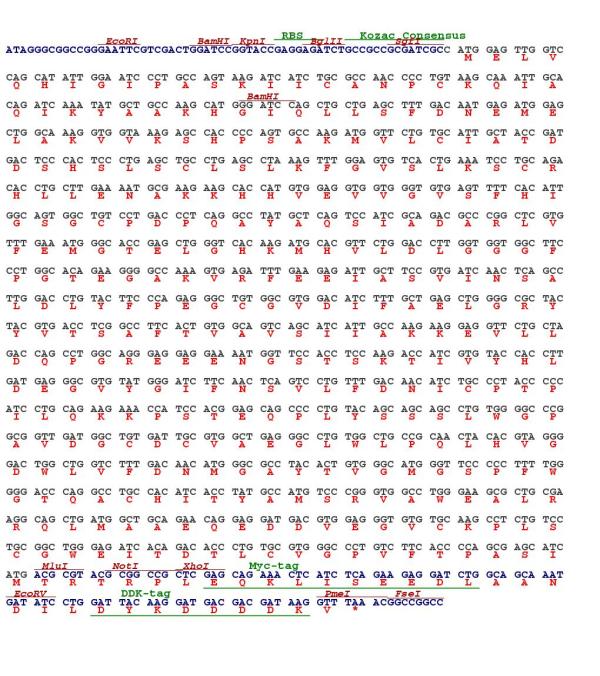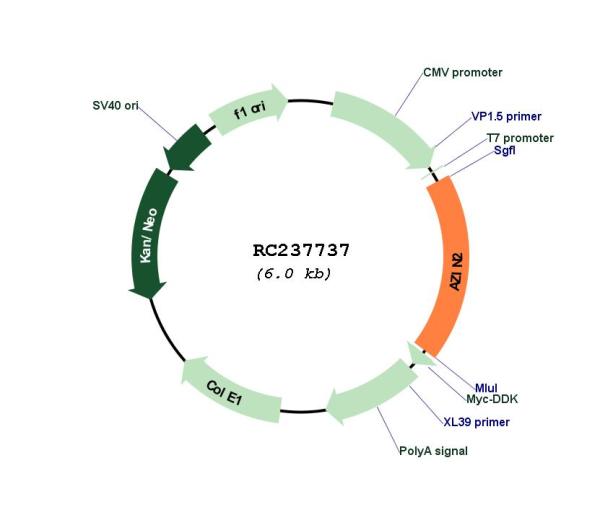AZIN2 (NM_001301823) Human Tagged ORF Clone
SKU
RC237737
AZIN2 (myc-DDK-tagged) - Human antizyme inhibitor 2 (AZIN2), transcript variant 3
-
TrueORF®
TrueORF®
Expression-ready ORF plasmid with C-terminal tag(s)
Click here to learn more.
| Product Data | |
| Type | Human Tagged ORF Clone |
|---|---|
| Target Symbol | AZIN2 |
| Synonyms | ADC; AZI2; AZIB1; ODC-p; ODC1L; ODCp |
| Vector | pCMV6-Entry |
| E. coli Selection | Kanamycin (25 ug/mL) |
| Mammalian Cell Selection | Neomycin |
| Sequence Data |
ORF Nucleotide Sequence
>RC237737 representing NM_001301823
Red=Cloning site Blue=ORF Green=Tags(s) TTTTGTAATACGACTCACTATAGGGCGGCCGGGAATTCGTCGACTGGATCCGGTACCGAGGAGATCTGCC GCCGCGATCGCC ATGGAGTTGGTCCAGCATATTGGAATCCCTGCCAGTAAGATCATCTGCGCCAACCCCTGTAAGCAAATTG CACAGATCAAATATGCTGCCAAGCATGGGATCCAGCTGCTGAGCTTTGACAATGAGATGGAGCTGGCAAA GGTGGTAAAGAGCCACCCCAGTGCCAAGATGGTTCTGTGCATTGCTACCGATGACTCCCACTCCCTGAGC TGCCTGAGCCTAAAGTTTGGAGTGTCACTGAAATCCTGCAGACACCTGCTTGAAAATGCGAAGAAGCACC ATGTGGAGGTGGTGGGTGTGAGTTTTCACATTGGCAGTGGCTGTCCTGACCCTCAGGCCTATGCTCAGTC CATCGCAGACGCCCGGCTCGTGTTTGAAATGGGCACCGAGCTGGGTCACAAGATGCACGTTCTGGACCTT GGTGGTGGCTTCCCTGGCACAGAAGGGGCCAAAGTGAGATTTGAAGAGATTGCTTCCGTGATCAACTCAG CCTTGGACCTGTACTTCCCAGAGGGCTGTGGCGTGGACATCTTTGCTGAGCTGGGGCGCTACTACGTGAC CTCGGCCTTCACTGTGGCAGTCAGCATCATTGCCAAGAAGGAGGTTCTGCTAGACCAGCCTGGCAGGGAG GAGGAAAATGGTTCCACCTCCAAGACCATCGTGTACCACCTTGATGAGGGCGTGTATGGGATCTTCAACT CAGTCCTGTTTGACAACATCTGCCCTACCCCCATCCTGCAGAAGAAACCATCCACGGAGCAGCCCCTGTA CAGCAGCAGCCTGTGGGGCCCGGCGGTTGATGGCTGTGATTGCGTGGCTGAGGGCCTGTGGCTGCCGCAA CTACACGTAGGGGACTGGCTGGTCTTTGACAACATGGGCGCCTACACTGTGGGCATGGGTTCCCCCTTTT GGGGGACCCAGGCCTGCCACATCACCTATGCCATGTCCCGGGTGGCCTGGGAAGCGCTGCGAAGGCAGCT GATGGCTGCAGAACAGGAGGATGACGTGGAGGGTGTGTGCAAGCCTCTGTCCTGCGGCTGGGAGATCACA GACACCCTGTGCGTGGGCCCTGTCTTCACCCCAGCGAGCATCATG ACGCGTACGCGGCCGCTCGAGCAGAAACTCATCTCAGAAGAGGATCTGGCAGCAAATGATATCCTGGATT ACAAGGATGACGACGATAAGGTTTAA
Protein Sequence
>RC237737 representing NM_001301823
Red=Cloning site Green=Tags(s) MELVQHIGIPASKIICANPCKQIAQIKYAAKHGIQLLSFDNEMELAKVVKSHPSAKMVLCIATDDSHSLS CLSLKFGVSLKSCRHLLENAKKHHVEVVGVSFHIGSGCPDPQAYAQSIADARLVFEMGTELGHKMHVLDL GGGFPGTEGAKVRFEEIASVINSALDLYFPEGCGVDIFAELGRYYVTSAFTVAVSIIAKKEVLLDQPGRE EENGSTSKTIVYHLDEGVYGIFNSVLFDNICPTPILQKKPSTEQPLYSSSLWGPAVDGCDCVAEGLWLPQ LHVGDWLVFDNMGAYTVGMGSPFWGTQACHITYAMSRVAWEALRRQLMAAEQEDDVEGVCKPLSCGWEIT DTLCVGPVFTPASIM TRTRPLEQKLISEEDLAANDILDYKDDDDKV |
| Restriction Sites |
SgfI-MluI Cloning Scheme for this gene
Plasmid Map

|
| ACCN | NM_001301823 |
| ORF Size | 1095 bp |
| OTI Disclaimer | The molecular sequence of this clone aligns with the gene accession number as a point of reference only. However, individual transcript sequences of the same gene can differ through naturally occurring variations (e.g. polymorphisms), each with its own valid existence. This clone is substantially in agreement with the reference, but a complete review of all prevailing variants is recommended prior to use. More info |
| OTI Annotation | This clone was engineered to express the complete ORF with an expression tag. Expression varies depending on the nature of the gene. |
| Components | The ORF clone is ion-exchange column purified and shipped in a 2D barcoded Matrix tube containing 10ug of transfection-ready, dried plasmid DNA (reconstitute with 100 ul of water). |
| Reconstitution Method | 1. Centrifuge at 5,000xg for 5min. 2. Carefully open the tube and add 100ul of sterile water to dissolve the DNA. 3. Close the tube and incubate for 10 minutes at room temperature. 4. Briefly vortex the tube and then do a quick spin (less than 5000xg) to concentrate the liquid at the bottom. 5. Store the suspended plasmid at -20°C. The DNA is stable for at least one year from date of shipping when stored at -20°C. |
| Note | Plasmids are not sterile. For experiments where strict sterility is required, filtration with 0.22um filter is required. |
| Shipping | Ambient |
| Reference Data | |
| RefSeq | NM_001301823.2 |
| RefSeq Size | 2023 bp |
| RefSeq ORF | 1098 bp |
| Locus ID | 113451 |
| UniProt ID | Q96A70 |
| Cytogenetics | 1p35.1 |
| Protein Families | Druggable Genome |
| Protein Pathways | Arginine and proline metabolism, Metabolic pathways |
| MW | 40.2 kDa |
| Summary | The protein encoded by this gene belongs to the antizyme inhibitor family, which plays a role in cell growth and proliferation by maintaining polyamine homeostasis within the cell. Antizyme inhibitors are homologs of ornithine decarboxylase (ODC, the key enzyme in polyamine biosynthesis) that have lost the ability to decarboxylase ornithine; however, retain the ability to bind to antizymes. Antizymes negatively regulate intracellular polyamine levels by binding to ODC and targeting it for degradation, as well as by inhibiting polyamine uptake. Antizyme inhibitors function as positive regulators of polyamine levels by sequestering antizymes and neutralizing their effect. This gene encodes antizyme inhibitor 2, the second member of this gene family. Like antizyme inhibitor 1, antizyme inhibitor 2 interacts with all 3 antizymes and stimulates ODC activity and polyamine uptake. However, unlike antizyme inhibitor 1, which is ubiquitously expressed and localized in the nucleus and cytoplasm, antizyme inhibitor 2 is predominantly expressed in the brain and testis and localized in the endoplasmic reticulum-golgi intermediate compartment. Recent studies indicate that antizyme inhibitor 2 is also expressed in specific cell types in ovaries, adrenal glands and pancreas, and in mast cells. The exact function of this gene is not known, however, available data suggest its role in cell growth, spermiogenesis, vesicular trafficking and secretion. Accumulation of antizyme inhibitor 2 has also been observed in brains of patients with Alzheimer's disease. There has been confusion in literature and databases over the nomenclature of this gene, stemming from an earlier report that a human cDNA clone (identical to ODCp/AZIN2) had arginine decarboxylase (ADC) activity (PMID:14738999). Subsequent studies in human and mouse showed that antizyme inhibitor 2 was devoid of arginine decarboxylase activity (PMID:19956990). Alternatively spliced transcript variants have been described for this gene. [provided by RefSeq, Sep 2014] |
Write Your Own Review
| Product Manuals |
| FAQs |
| SDS |
Citations
*Delivery time may vary from web posted schedule. Occasional delays may occur due to unforeseen
complexities in the preparation of your product. International customers may expect an additional 1-2 weeks
in shipping.






